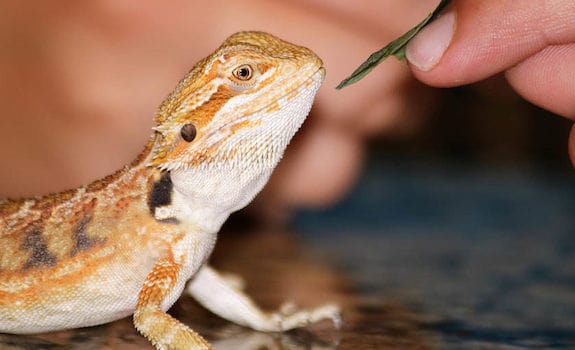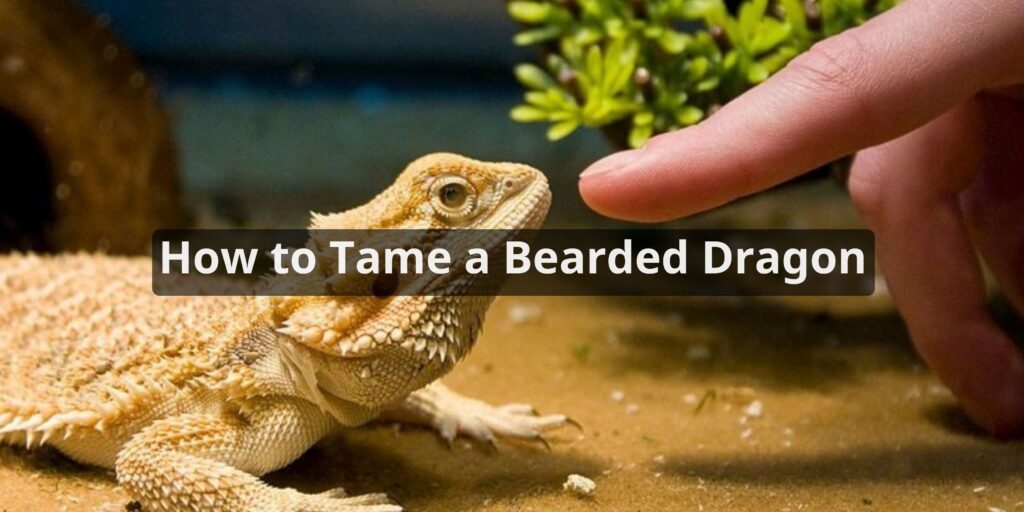Bearded dragons make great pet reptiles. They are generally docile, easily handled, and relatively easy to care for. However, bearded dragons can be skittish and intimidated when first brought home. With time and patience, you can tame your bearded dragon to enjoy being handled. Here is a step-by-step guide on how to tame a bearded dragon.
Build Trust

The key to taming a bearded dragon is building trust. When you first bring your bearded dragon home, allow time for it to settle into its new habitat. Resist the urge to try handling it right away. Instead, interact with it calmly and positively. Place your hand in the enclosure and allow the bearded dragon to approach you and smell you. This allows the bearded dragon to become accustomed to your scent and presence. Repeat this daily, gradually placing your hand closer as the bearded dragon seems comfortable.
Once the bearded dragon seems relaxed around your hand, you can attempt gentle petting along the head and back. Avoid sudden movements or grabbing at first. Let the bearded dragon walk onto your hand to get used to climbing on you. With each interaction, offer treats like chopped fruits or insects to associate your presence with good things. In time, the bearded dragon will look forward to your visits and handling.
Establish a Routine
Bearded dragons thrive on regular routines. Set up a daily schedule for feeding, handling, and habitat cleaning. Try to interact with your bearded dragon at the same times each day. The predictability will be reassuring and prevent fear responses like black beards or puffing up.
When handling your bearded dragon, limit sessions to about 10-15 minutes at first. Slowly increase handling time as you build trust. Avoid bothering a sleeping or shedding bearded dragon. Pay attention to stress signals like darkened beards and thrashing tails. Return the bearded dragon to its enclosure if it seems distressed. With routine handling, it will learn not to fear being picked up.
Use Positive Reinforcement
Reward-based training is very effective with bearded dragons. When your bearded dragon responds calmly to handling, offer a treat. This reinforces the behavior you want to see. Favorite motivators include mealworms, crickets, berries, mangos and bananas.
You can also use treats to lure a timid bearded dragon onto your hand. Place a tasty worm or fruit right near your hand and allow the bearded dragon to voluntarily walk over to eat. Gradually move the food closer to get the bearded dragon climbing onto you. Reward with the treat when it does. With time, the bearded dragon will associate treats and handling.
Make Changes Gradually
It’s important not to overwhelm a bearded dragon as you tame it. Introduce changes slowly, from new foods to handling. Move your hand gradually closer in the enclosure over multiple days or weeks based on the bearded dragon’s reactions. Increase handling time in small increments as well. Drastic changes are more likely to scare a bearded dragon and undermine taming progress.
If you need to move the bearded dragon to a new enclosure, place items from the old cage in the new one too. This helps it feel secure with familiar smells. Handle the bearded dragon in the new habitat right away so it also associates that space with you positively. Make all habitat and dietary adjustments over an extended timeframe.
Avoid Aggression Triggers

Some things are known to trigger aggressive behavior in bearded dragons, which can setback taming. Avoid the following:
- Handling around breeding season, when males may see hands as rivals
- Petting near the tail or grasping the legs, which can feel like attacks
- Approaching from above, which can seem predatory
- Loud noises, bright lights, and quick movements that seem threatening
- Handling when in blue phase of shedding cycle, which is uncomfortable
- Disturbing during sleep, as waking up is disorienting
By avoiding these stressors and antagonistic triggers, you create a calmer environment for successfully taming your bearded dragon.
Be Patient
Taming any reptile takes immense patience on your part. Some bearded dragons warm up to handling in a few weeks. More timid ones may take months before feeling secure around you. Work at your bearded dragon’s pace and do not force interactions. With time, it will come to enjoy your companionship through routine, positive reinforcement, trust, and minimal stress.
Conclusion
Taming a bearded dragon requires understanding reptile behavior and taking it slow. Let your bearded dragon adjust to its new home before extensive handling. Build trust with calming interactions and treats. Develop a consistent daily routine of feeding and handling. Use reward-based training and make habitat changes gradually. Avoid anything that seems to stress your bearded dragon. With regular, gentle handling sessions, you can have a friendly pet bearded dragon that tolerates or even enjoys human interaction. The key is being patient and responsive to your bearded dragon’s needs.
FAQs About How to Tame a Bearded Dragon
What are the best methods for handling and interacting with a bearded dragon?
Handle your dragon calmly, support its body, avoid sudden movements, and gradually increase handling time as it becomes more comfortable.
Are there specific training techniques to tame a bearded dragon?
Use positive reinforcement with treats, gentle handling, and patience. Avoid punishment or forceful methods that can increase fear.
How can I socialize my bearded dragon with other pets or people?
Introduce other pets or people gradually in a controlled environment to avoid stress. Monitor interactions and prioritize safety.
What should I do if my bearded dragon shows signs of stress or fear during taming?
If stressed, give your dragon a break, return it to its enclosure, and provide a quiet, comfortable environment. Resume taming gradually.
Can taming a bearded dragon improve its overall quality of life?
Yes, taming promotes mental stimulation, reduces stress, and enhances the dragon’s well-being. It also facilitates easier health checks and care.



